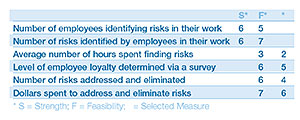Step 3 designs meaningful measures. Barr cautions against brainstorming; using existing data, legacy measures, or industry benchmarking; outsourcing selection to consultants. Instead, she advocates her five steps of meaningful measure design.2
Begin with the end in mind. Write down the result you want from a measure. Ideally, it comes from the results map or the business’ strategic plan, such as — Eliminate all risks that could lead to a fatality.
Next, describe the result in terms of how someone would see, feel, hear, taste, smell or otherwise experience the result, if it were occurring.
1. We would see employees’ contribution to identifying risk increase.
2. Employees would feel a strong desire to work here and nowhere else.
3. We would hear employees talking about the risks they have found.
4. We would sense the “smell” of safety in the air.
5. We would observe appreciation for committing financial resources to reduce or eliminate risks discovered by employees.
Once you describe the results, identify potential measures that will tell you if the results are being achieved. Evaluate your measures with two questions: 1) How strong an indicator is this measure of the results? 2) How feasible will it be to measure this? Use a seven-point scale from low to high. (See chart on next page)

Unintended consequences
Next, determine if there will be any unintended consequences of measuring the selected result, either positive or negative. For example, what behaviors might become evident based on the measure chosen? Are there other areas that might be sabotaged or limited? According to Barr, although it may be important to measure things in your circle of control, the measures with the most power are those that measure results within your circle of influence.
The last step: name the measure using a brief three- to five-word unique name. And write a brief sentence describing the measure in enough detail so that you can picture how it will be calculated.
Step 4 is to build buy-in for your chosen performance measures. Without ownership across the organization for the performance measures you decide to use, the likelihood of honestly achieving the performance you are seeking will be limited.
An interesting technique to gain buy-in according to the performance measures is to create a PuMP Measure Gallery. To succeed, Barr encourages the Measures Team to determine who needs to be invited to the Gallery, send out invitations versus mandating attendance, conduct the Gallery showing in a space that allows for dialogue, allow the Gallery to be open all day so word will travel encouraging more to attend, ask attendees to provide honest and constructive feedback about the performance measures.3
Just do it
Step 5: to implement, the Measures Team must determine how the measures are going to be calculated, identify the necessary data, and ensure the right things are measured in the right ways. Barr provides eight steps for defining a performance measure: Description, Intent, Where it Fits, Calculation, Presentation, Response, Owners, and Notes.4
Write the Description of the measure so that those who use it quickly understand its meaning. Barr recommends defining the measures being monitored in terms of the characteristics of what you are measuring, the quantification of these characteristics, and the scope boundaries of the measures.
Next define why the measures are needed. To determine the Intent, answer the following questions: 1) Why is it so important we measure this? 2) What’s the driving priority behind the measure? 3) What important difference will the measure help us make?
Where does it fit? Depending upon the number of measures you are managing, it is worthwhile to establish what each measure relates to with respect to the business process, functional unit, goals, etc.
Next, how will you perform the Calculation of the measure from the raw data? After selecting the formula, define the frequency, clarify the scope, and identify the required data sets and their sources.
Regarding Presentation, it’s critical that the data tell their story. Choose the visual display that conveys the message of the performance measure in a way that is clear, valid, and does not lead to misinterpretation or misuse.
Possible measurement outcomes
The most important outcome of developing and utilizing performance measures is the Response to the observed measures. The basic Response signals are: 1) Performance has reached or exceeded the target; 2) Performance is improving at a fast enough rate to reach the target; 3) Performance is improving, but not fast enough; 4) Performance is stable and not changing; 5) Performance is getting worse; and 6) Performance is unpredictable or chaotic. Each of these signals has attendant intervening actions that may or may not need to be taken.
Barr wisely recommends that a performance measure Owner be identified to define, coordinate the presentation, clarify discrepancies, either owns the sources of the data or knows how to access the data, and provides interpretations.
Finally, provisions need to be made to capture improvement ideas, intended life span of the measures, analysis and reporting procedures, and other points to consider when reporting or using performance measures in a collection of Notes.
Next month I’ll finish this series on performance measures with reporting performance measures, interpreting signals from measures, and reaching performance targets.
1 Barr, S. 2014. Practical Performance Measurement – Using the PuMP Blueprint for Fast, Easy, and Engaging KPIs. The PuMP Press. Samford Qld, Australia.
2 Ibid. pp. 160-172.
3 Ibid. pp. 175-195.
4 Ibid. pp. 211-238.




